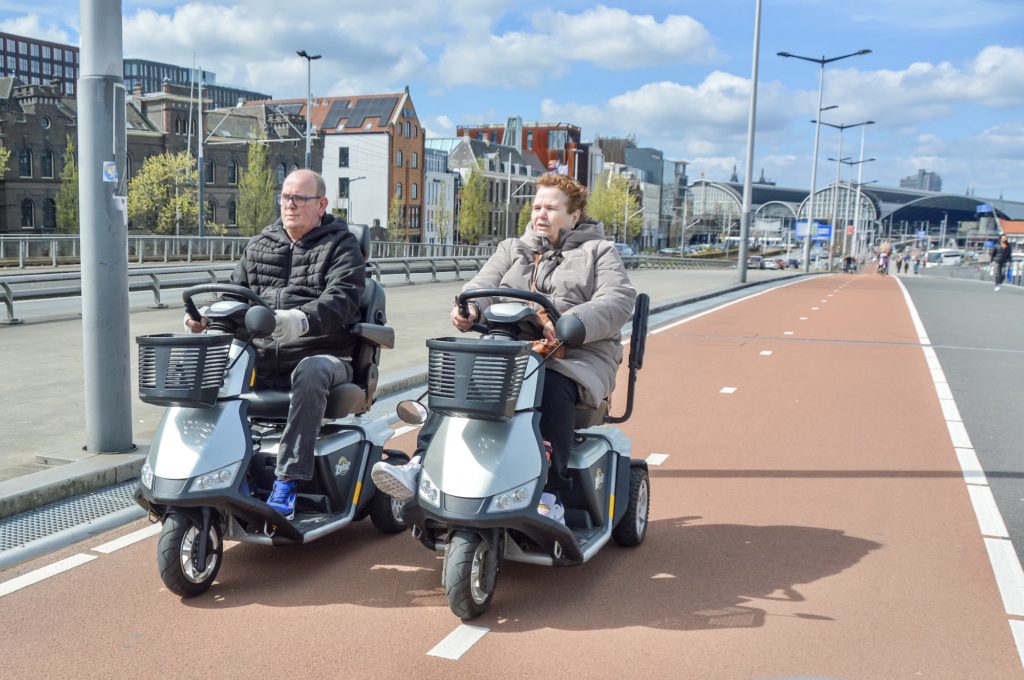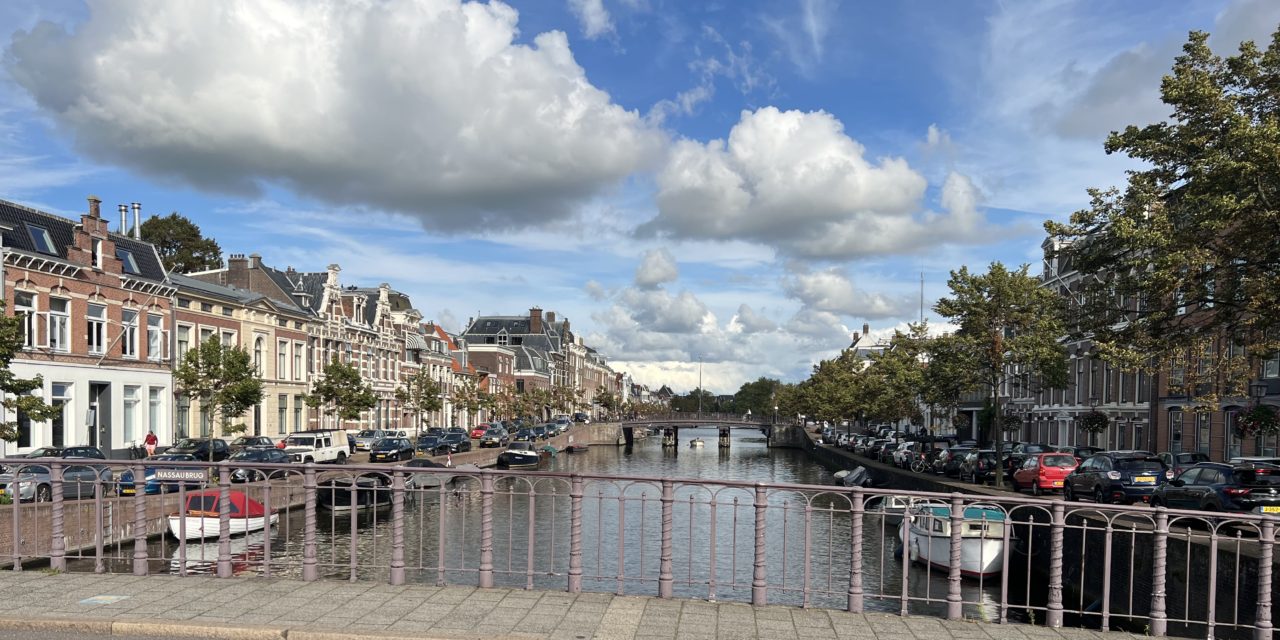Planning and taking an overseas trip to Europe isn’t easy but it’s so worth it! My wife and I recently enjoyed a three-week vacation in Europe. In this article, I will share some of the lessons we learned and our best European travel tips, especially for senior adults.
Not being experienced international travelers, our trip wasn’t without its share of stresses and challenges. Even so, we’re glad we went. If you can visit Europe, by all means, do so. It’s a fascinating continent full of charm, history, scenic beauty, and wonderful people.
Our only regrets are that our time in the Netherlands, Germany, and Switzerland went by far too fast and we didn’t get to see more.
Packing Tips

Kathy with her carry-on bag and personal item; we did not check a bag on the way to Europe.
Prior to the trip, we wrestled for weeks over whether to check bags on our flights or travel with only carry-on bags and personal-item bags. After reading advice on travel websites and talking with friends who are more experienced travelers, we decided not to check bags. That meant having to be smart packers, taking only the most essential clothes, shoes, and accessories. We did a trial run packing exercise two weeks prior to our trip and found we had sufficient room (just barely) for our stuff without using one or more larger checked bags.
We opted for fast-dry clothes where possible, avoiding cotton fabrics, so we could wash clothes in our room and re-wear them. We kept our wardrobes simple and casual. My wife found lightweight accessories such as scarves to be an easy way to dress up her outfits. We weren’t always the most fashionable people around, but in the end, who cares? We were strangers in a foreign land. Comfort and convenience mattered most.
While we’re talking about packing, if you are traveling to Europe from the U.S. and are accustomed to using washcloths when you bathe or shower, you better bring your own. Washcloths (small towels for bathing) are not commonly used in Europe. They are also considered a very personal item, never to be shared, so even if Europeans used one, they would bring their own when traveling. We brought some old, worn washcloths from home that we could discard before flying home.
For do-it-yourself travelers like us (more on that topic later), we think we made the right decision about packing. I can’t imagine lugging a larger checked bag around the cobblestone streets and steep stairs of Europe and on and off of buses and trains.
One lesson we learned is the value of wheeled luggage for a trip that involves a lot of walking. Kathy had a wheeled carry-on bag. She could move about easily by placing the smaller personal item bag on top of the carry-on bag and rolling both of them together. I choose to use a relatively large backpack for my carry-on bag, plus a separate personal item bag. As I walked, the backpack got heavier and heavier. The back of my shirt was drenched with sweat. Plus, I also had to carry the personal item bag on my shoulder. For the future, a small backpack that counts as a personal item might be OK if necessary, but never again will I attempt a trip like this without a rolling bag.
For the return flights home, we decided to check my heavy backpack. That made travel much more pleasant. Unfortunately, the backpack didn’t arrive at our destination airport in the U.S. when we did. It took four more days and several phone calls to get the backpack returned to us. That’s another reason we didn’t want to check a bag in the first place. Fortunately, an Apple AirTag was hidden in the backpack, so we knew at all times where the bag was.
(See this accompanying story on This Retirement Life about things to buy before your big trip, including AirTags.)
Trains, Trams, and Buses

Europe is so much easier to get around than the U.S. or Canada. Its world-class mass transit network includes buses, trams, and trains. We spent three weeks in Europe and never needed a car. While many Europeans own cars, it would be easy to imagine living there and getting around just fine without one, as many Europeans do.
In the Netherlands, a typical practice was for people to ride their bicycles or take a bus to the train station. Nearly all train stations had nearby bus terminals. Some of the larger train stations have parking garages that hold thousands of bicycles. Yes, a parking garage for bikes! That’s an idea that hasn’t made its way to the U.S. yet. The train network in Holland is so good that there are no domestic flights within the country. Who needs airplanes when you can go from Amsterdam to Rotterdam on a comfortable train in just over an hour for about $20? Miss your train? No worries. Another one will often come along in just a few minutes and you won’t need to change tickets.
We rode many local or regional buses and trains in the Netherlands and Germany, as well as longer-distance, high-speed trains from Holland into southern Germany (Haarlem to Friedrichshafen). You have much more legroom on trains compared with airplanes, there are no fees for bringing your luggage with you, and some of the long-distance trains offer food service. You don’t have to go through TSA security. It’s a great way to travel.
Every form of long-distance transportation has its challenges, and that includes Europe’s trains. As wonderful as they are, they aren’t perfect. We had to re-route one day due to construction ahead on the tracks, adding considerably to our travel time. Our most stressful day on the trains was when the high-speed German train we were riding south of Frankfurt stopped for reasons we still don’t know. All of the instructions over the loudspeaker were in German, so we were clueless as to what was happening. Everyone on the train had to exit. We were directed to another train, but since it was already full of passengers, we had to stand for the rest of our journey, over an hour, packed in tightly with other travelers on a very hot summer day. We called it our “cattle car” experience. That delay caused us to nearly miss our next connection. Watching two 70-year-olds racing through a train station, bags in tow and dripping with sweat, isn’t a pretty site!
By the way, we met so many friendly people along the way. As we were racing through the train station trying to catch our connecting train, a kind woman took pity on us and helped Kathy with her larger bag going up a very tall set of stairs. I don’t think we would have made the connection without her help.
Even with these misadventures, I would still highly recommend train travel in Europe. It’s comfortable, fast, and easy to maneuver. Riding the trains in Europe reminds you of how far behind we are in America when it comes to mass transit.
Pros and Cons of Traveling DIY
While we used a travel agent to book our airfares and advise us on some of our lodging choices, for the most part, we chose the do-it-yourself (DIY) travel method rather than going with a travel package through a tour company or cruise line. Both methods have their advantages. I’m one of those guys who likes to do the research and feel in control of the itinerary. When you travel DIY, you can customize your itinerary more easily than when booking a travel package through a tour company or cruise. It’s nice to be able to change plans at the last minute compared with being herded along to the next amazing photo op by a tour guide. You might also save money by planning the trip yourself.
Planning your trip DIY is best if you enjoy researching your destinations and how to get there. We spent several months reading books and searching online to gain travel tips for traveling in the Netherlands, Germany, and Switzerland. We created a detailed trip itinerary using the TripIt app, which I highly recommend (and they aren’t paying me to say so).
(See my accompanying story on This Retirement Life about some of the best travel apps and websites.)
One big plus for tours and cruises is that all of the logistics are taken care of. You don’t have to lug your baggage around. You don’t fret about getting lost. The language barrier isn’t as much of an issue. Hotels are booked for you. Traveling on our own without a tour guide, we did get confused at times about directions, but we found local people nearly always happy to help us.
On a tour, the price usually includes handling your luggage. You don’t have to worry about it. Europe being Europe, we had to carry our bags up steep steps that seemed to never end. If we were college students or even middle-aged, the luggage issue might not have been a problem, but we’re bonafide senior citizens, with Medicare cards to prove it. When you travel in Europe’s historic city centers, you can expect lots of cobblestone streets and stairs. Wear good walking shoes and keep your luggage light!
Another benefit of tour companies is that they can get you access to the major tourist attractions. A major disappointment for us was that we could not get tickets to see either the Corrie Ten Boom house or Ann Frank’s family home in the Netherlands, even though we tried to purchase tickets online a full month in advance. They were already sold out. Tour companies often get preferential access to tickets and know how to negotiate deals.
Tours and cruises are especially nice for solo travelers and anyone looking forward to making new friends while traveling. On the other hand, Kathy and I got to talk with many local people on buses and trains and in the cities we visited. Nearly everyone we encountered was friendly and helpful. I suspect this type of cultural interaction wouldn’t happen as often when you’re part of a tour group.
Now that the trip is over, Kathy and I are not unhappy with our decision to plan the trip ourselves. We have, however, gained a greater appreciation for the benefits of packaged tour trips and river cruises, especially for senior adults. The next time we consider a major trip like this, we may do it DIY again but will also explore the options of using a tour company or taking a river cruise. As we age further, tours and cruises will likely grow in their appeal.
Consider Your Age and Health
Travel is one of the greatest pleasures of the retirement years. It’s not until this stage of life that many of us have the time and money to conduct international travel. The irony, however, is that as seniors we no longer have the strength and stamina we once did. Travel is harder on our bodies at this stage of life. No matter how hard we fight it or try to deny it, aging takes a toll on all of us.
One of the best decisions we made was to schedule some down days into our itinerary. You can’t book yourself with a full day of activity every day. You’re going to need some rest. Be realistic about how much you can see and do. You won’t be able to visit all the wonderful museums, cathedrals, and historic sites that you read about when planning the trip. It’s OK. See what you can while not exhausting yourself.
When you travel to Europe’s tourist centers, you can expect to walk a lot. We walked an average of 9,000 to 12,000 steps per day, far more than a typical day back home. In the old city centers, cobblestone streets are common. Parts of Europe are hilly. Wearing comfortable shoes with good support is important.
In preparation for going to Europe, Kathy and I started conditioning ourselves in the weeks leading up to the trip by visiting the gym more frequently and taking walks. One priority for me was building my upper body strength to be better able to lift luggage, especially into overhead bins. The extra conditioning helped.
You’ll have to honestly assess your own health before scheduling a major trip like this. If in doubt, ask your doctor if you’re healthy enough to travel.
Rethinking Senior Living

Seniors in the Netherlands enjoy greater freedom and mobility due to bike paths and mass transit. Photo courtesy of the Dutch Cycling Embassy.
As a retirement-living blogger, going to Europe made me question some of the assumptions we North Americans hold about what makes an ideal place to retire. For many of us, the dream is to retire to a single-family house in a sprawling 55+ community, like The Villages in Central Florida or one of the many Sun City retirement communities. More often, we choose to stay put in our existing large home in suburbia where we raised the kids. The trouble with this American retirement dream is that single-family homes in the suburbs add to our social isolation and loneliness. We are often in communities where the only way to get around is by car, so as we age we become trapped inside our own homes.
The European model is different, especially in countries such as the Netherlands. Senior adults can remain more independent and active there thanks to excellent bicycle infrastructure and mass transit. The famous bicycle paths in Holland aren’t just for bicycles. We saw plenty of seniors on two-wheel bikes, three-wheel trikes, and mobility scooters. Electric bikes and trikes (e-bikes) are making mobility easier for seniors. Even the more elderly members of society and those with mobility issues can still get out, socialize, and maintain a greater degree of independence. Europeans also walk a lot more than the typical American, which helps seniors get the exercise and fresh air they need to maintain strong physical and mental health.
Like most everyone else in the Netherlands and many other European countries, senior adults there are more likely to live in multi-family housing developments, ranging from townhomes to high-rise apartments. This form of urban design makes cities much more compact. As a result, nearly everything a senior needs, from shopping to healthcare, is just a few minutes away by walking or cycling. If they need to go farther, they can catch a bus or train.
The European model for retirement living offers an interesting contrast to the typical American retirement dream. If you look for them, there are a growing number of communities here in North America that mimic the traditional model for European city design. Look for towns or new developments practicing new urbanism or the 15-minute city concept. So far, most of these developments in North America are upscale and not a choice for average-income retirees. Hopefully, that will change over time.
Go Now, Don’t Wait
Everyone ages differently but as a general rule, the early retirement years are the best for extended travel. Somewhere along the way, often in the late 70s or early 80s, most senior adults lose their passion for long-distance travel. Other seniors will be forced to the sidelines by health setbacks, either their own or a spouse’s. Financial constraints can also put a damper on travel plans for seniors.
I hope these tips for European travel for seniors have been helpful. If you are a senior adult and considering taking a major bucket list trip, my advice is to do it now. Don’t wait.
* * * * *
What are your best travel tips for traveling to Europe? Share your best ideas in the comments section below.
* * * * *
You may also enjoy reading:
Best Travel Apps and Websites
Travel Items to Buy Before Going to Europe
Experiencing a Netherlands Bike Tour
Love this story? Sign up below to receive future blog posts from This Retirement Life, sent to your email box, free of charge.








